Nissan Sentra Owners Manual: Tire pressure
Tire Pressure Monitoring System (TPMS)
This vehicle is equipped with the Tire Pressure Monitoring System (TPMS). It monitors tire pressure of all tires except the spare. When the low tire pressure warning light is lit and the CHECK TIRE PRES warning is displayed in the odometer, one or more of your tires is significantly under-inflated.
The TPMS will activate only when the vehicle is driven at speeds above 16 MPH (25 km/h). Also, this system may not detect a sudden drop in tire pressure (for example a flat tire while driving).
For more details, refer to тАЬLow tire pressure warning lightтАЭ in the тАЬInstruments and controlsтАЭ section, тАЬTire Pressure Monitoring System (TPMS)тАЭ in the тАЬStarting and drivingтАЭ section, and тАЬFlat tireтАЭ in the тАЬIn case of emergencyтАЭ section.
Tire inflation pressure
Check the tire pressures (including the spare) often and always prior to long distance trips. The recommended tire pressure specifications are shown on the F.M.V.S.S./C.M.V.S.S. certification label or the Tire and Loading Information label under the тАЬCold Tire PressureтАЭ heading.
The Tire and Loading Information label is affixed to the driver side center pillar. Tire pressures should be checked regularly because:
- Most tires naturally lose air over time.
- Tires can lose air suddenly when driven over potholes or other objects or if the vehicle strikes a curb while parking.
The tire pressures should be checked when the tires are cold. The tires are considered COLD after the vehicle has been parked for 3 or more hours, or driven less than 1 mile (1.6 km) at moderate speeds.
The тАЬTPMS with Easy Fill Tire AlertтАЭ provides visual and audible signals outside the vehicle for inflating tires to the recommended COLD tire pressure. For more information, see тАЬTPMS with Easy Fill Tire AlertтАЭ in the тАЬStarting and drivingтАЭ section.
Incorrect tire pressure, including under inflation, may adversely affect tire life and vehicle handling.
WARNING
|
Tire and loading information label
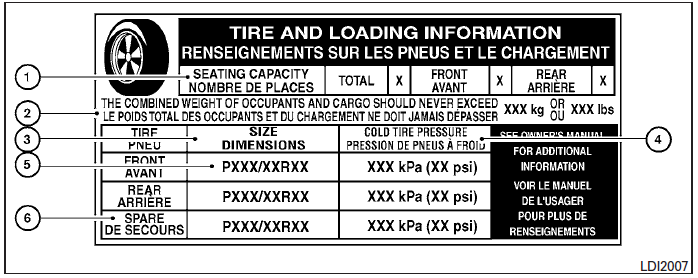
- Seating capacity: The maximum number of occupants that can be seated in the vehicle.
- Vehicle load limit: See тАЬVehicle loading informationтАЭ in the тАЬTechnical and consumer informationтАЭ section.
- Original tire size: The size of the tires originally installed on the vehicle at the factory.
- Cold tire pressure: Inflate the tires to
this pressure when the tires are cold.
Tires are considered COLD after the vehicle has been parked for 3 or more hours, or driven less than 1 mile (1.6 km) at moderate speeds. The recommended cold tire inflation is set by the manufacturer to provide the best balance of tire wear, vehicle handling, driveability, tire noise, etc., up to the vehicleтАЩs GVWR.
- Tire size тАУ refer to тАЬTire labelingтАЭ in this section.
- Spare tire size.
Checking tire pressure
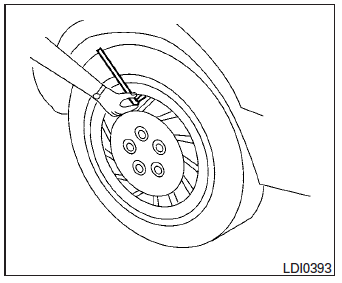
- Remove the valve stem cap from the tire.
- Press the pressure gauge squarely onto the valve stem. Do not press too hard or force the valve stem sideways, or air will escape. If the hissing sound of air escaping from the tire is heard while checking the pressure, reposition the gauge to eliminate this leakage.
- Remove the gauge.
- Read the tire pressure on the gauge stem and compare to the specification shown on the Tire and Loading Information label.
- Add air to the tire as needed. If too
much air is added, press the core of
the valve stem briefly with the tip of
the gauge stem to release pressure.
Recheck the pressure and add or release air as needed.
- Install the valve stem cap
- Check the pressure of all other tires, including the spare.
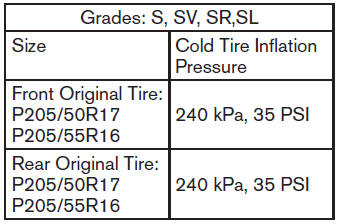
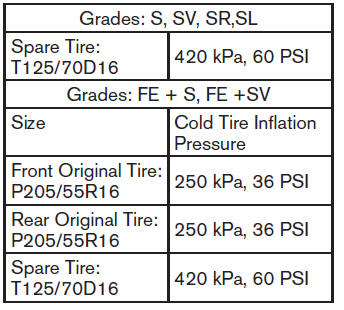
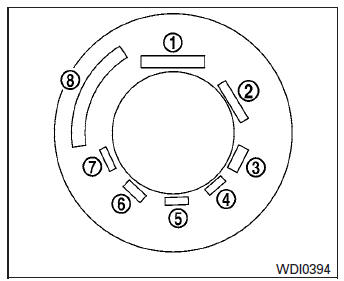
Example
 Wheels and tires
Wheels and tires
If you have a flat tire, see тАЬFlat tireтАЭ in the
тАЬIn case of emergencyтАЭ section of this
manual. ...
 Tire labeling
Tire labeling
Federal law requires tire manufacturers to
place standardized information on the
sidewall of all tires. This information identifies
and describes the fundamental
characteristics of the tire and al ...
Other materials:
B00D5 Passenger air bag OFF Indicator
Description
DTC B00D5 FRONT PASSENGER AIR BAG OFF INDICATOR
The front passenger air bag off indicator is wired to the air bag diagnosis
sensor unit. The air bag diagnosis
sensor unit monitors the front passenger air bag off indicator and circuit for
failures.
PART LOCATION
Refer to SRC-5, ...
Fuel injector and fuel tube
Exploded View
Bracket
Fuel tube bracket
Fuel feed tube
Quick connector cap
Fuel tube
O-ring (black)
Fuel injector
O-ring (green)
Injector clip
CAUTION:
Do not remove or disassemble parts unless instructed.
Removal and Installation
WARNING:
Put a ╨▓╨В╤ЪCAUTION: FLAM ...
When traveling or registering your vehicle in another country
When planning to drive your NISSAN vehicle
in another country, you should first find
out if the fuel available is suitable for your vehicleтАЩs
engine.
Using fuel with an octane rating that is too low
may cause engine damage. All gasoline vehicles
must be operated with unleaded gasoline. The ...
